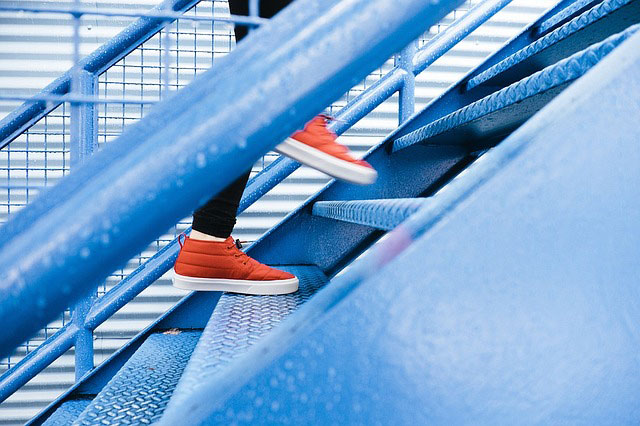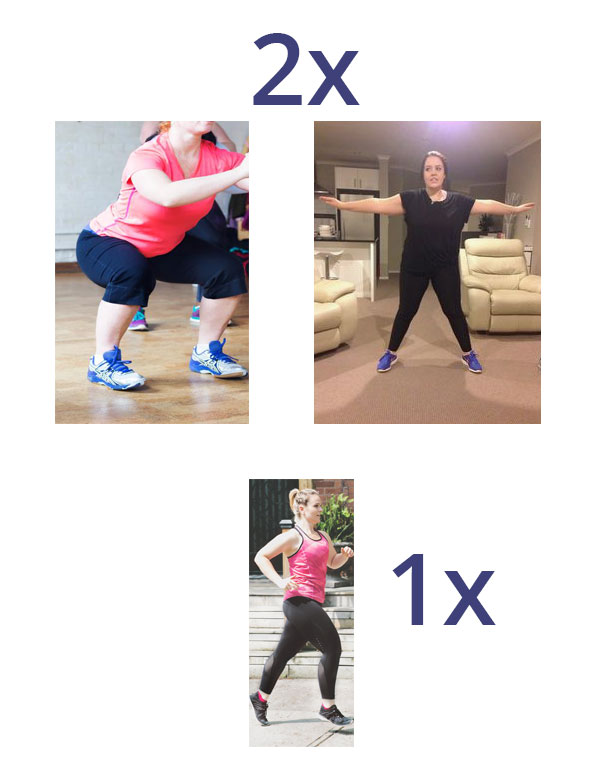If you are trying to clock up 10,000 steps a day to keep your Fitbit happy you are just wasting your time. 10,000 steps is a marketing ploy. It is being used as a USP by all the major fitness tracking brands looking to offload their merchandise to health conscious consumers.
Or perhaps it’s the fear put out by this “bad science” that’s being used by the smart fitness fraternity. Fear sells. If companies can get you questioning your health, you will buy their products if they will “fix” the problem.
– If companies could get your flexing your abs whilst wearing an electronic band to lose weight they would. Wait, they already do! Pure crap.
With the case of 10, 000 steps a day, it’s getting fit. Lowering your heart rate, losing weight. And what better way to do it than to just incorporate it into your daily routine. Perfect for people who don’t like curling dumbbells in the squat rack at the gym or prefer to work out at home.
Walking is the most obvious way to get fit, isn’t it?

Given you might have to walk around the car park at the office an extra 10 times at lunch, or take the stairs from the 10th floor to ground level 5 extra times per day. Hike up a mountain on the way home. Take the dog out again or do 2 more laps of the beach…
With up to 60% of the American population NOT taking part in daily physical activity, you would think getting an activity monitor is the solution to this problem.
But is 10,000 steps a day doing any good? Why is it this figure anyway? What if you are already doing 10K steps a day or more – are you already fit?
Let’s look at the science.
Moderate To Brisk Exercise Scientifically Proven To Be Better Than Light Exercise
It seems too good to be true, but brief high paced exercise is actually more beneficial to your health than slow steady state cardio. If you think HIIT (high intensity interval training) is just another workout routine, uh-uh. Not only is it quicker, but it is more efficient.
This research study by Dr James Blackwell and Dr Beth Phillips revealed 30 mins of interval training burns more fat, lowers your resting heart rate, and increases your cardiovascular fitness better than 60 minutes of slow paced jogging.
Other benefits of HIIT include lowering your blood pressure, reducing risk of diabetes (by increasing insulin sensitivity), burning more fat, and increasing strength when compared to slow paced exercise.
And there are lifelong health benefits too and not just intermediate fitness boosts:
50 000 walkers were analyzed over a 14 year period in Britain. Those who did NOT stroll at a slow pace had a 20% lower risk of premature death, and lowered their risk of dying from heart disease or a stroke to 24%.
HIIT should not be the only type of exercise you perform, as this breaking muscle article explains. Getting stuck with one type of exercise is not ideal. The purpose is to show you what you are missing out on if it’s not included in your workout arsenal.
No Time To Exercise – NO EXCUSE
What if you walked 20,000 steps per day? Would that do? Don’t believe the hype that a certain number of steps (pull a figure out of the air) is going to transform your health and fitness or enable you to lose 30 pounds. This false negative fools busy individuals who know they should exercise but just can’t get started.
Taking the extra mile is ineffective. Less is definitely more- max results in minimum time. Try that on an Assault bike and it will only take a few minutes.
Where Does The Mystical Ten Thousand Number Come from?
10 thousand steps has become a huge health mantra. Over 50% of Americans and 82% of Brits report using a fitness tracker daily. In 1964 the Manpo Meter was invented in Japan during the run up to the Tokyo Olympics. This device was a pedometer and the name translates literally as: 10 Thousand Step Meter. This is how this “magic” number became the goal.
This product was cleverly marketed with “10,000 steps as it’s slogan (slick marketers would sell snow to Eskimos) without any basis in scientific research, and now, lazily, in the interest of repeating history and making an easy buck, fitness tracking brands, and more importantly, their marketing managers, have duped an unquestioning public for the second time.
Like taking candy from a baby.
This Is A Better Way Than 10, 000 Steps – You Don’t Need A Gym Neither
It is better to concentrate on an exercise routine like HIIT that segments your effort into short bursts. You have to break a sweat and you need to get your heart rate up to an elevated level. Then you back off, let your heart rate recover and then ramp up the speed again.
BEFORE STARTING you need to do a benchmark test to measure your current fitness levels. This test is used as a universal standard to test your cardiovascular fitness and strength levels. For this all you need is a chair and a watch.

Chair Test
Sit down on a chair and stand up. Do this 10 times and measure how many seconds it takes. This test measures your strength. It tests the quadriceps muscles at the front of your thigh and also the glutes, the biggest muscles in your body. These muscles weaken if you don’t use them, so the test is to see where your lower body strength is currently at.
Age Benchmarks
- Men Under 35 should do 10 in 10 secs or less. Women under 35 should do 10 in 12 secs.
- Men 35-55 should do it in 13 secs. Women 35-55 in 15 secs
- Men over 55 should do it in 18 secs. Women over 55 in 19 secs.
Step Test
This is a universal test for measuring aerobic fitness levels- that is, how strong the lungs and heart are. When you are out of shape, your heart has to work harder to pump blood and oxygen to your tissues. The benefit of increasing your aerobic fitness is that your heart doesn’t have to work as hard when you are not involved in physical activity.
An exercise step or your stairs will do for this one as well as a watch. Step on and off a step interchanging the feet for 3 minutes. Both feet have to step up before both step down. You must use a moderate walking pace. It helps to use this rhythm as you step: up-up-down-down.
At the end put your index finger on your wrist or neck and count your pulse for 60 seconds. (or 15 secs and multiply by 4).
Age Benchmarks
- Men under 35 bpm should be under 105. Women under 35 bpm should be 110
- Men 35-55 bpm should be under 110. Women 35-55 bpm should be 115
- Men over 55 bpm should be under 115. Women over 55 bpm should be 115
Your goal is to get to the figures for your age bracket above. If you are there already keep at it. If you are not, some improvements are needed. But how do you get there? Well you can repeat the test, working on increasing your speed on the chair test. You can also repeat using the moderate walking pace on the step test, your heartbeat will go down the more you get used to it.
Heart rate is a good indicator of your fitness, as the fitter you are the less fast your heart has to beat. This test has been designed for all ages so getting fit in your 40’s and 50’s is easy at home.
Testing over. Now it’s actually time to get fit.
HIIT Routine You Can Do At Home
This routine involves 5 minutes of intense cardio and you don’t need any equipment. It is some simple, but don’t let that fool you
- Warm up by lightly jogging on the spot for 1 minute
- Perform regular star jumps or jumping jacks for 1 minute then take 30 sec rest
- Perform body weight squats for 1 minute then take a 30 sec rest
- Perform static sprinting on the spot for 60 sec then take a 30 sec rest
- Perform squats again for 1 minute then take a 30 sec rest
- Perform star jumps again for 1 min then cool down with a light jog for 1 minute

No need for exercise bikes, elliptical machines or treadmills.
10K Steps Vs HIIT
Sheffield University professor Rob Copeland explored the concept of 10k steps. The aim was to find if there was something else that would offer more bang for your buck and in much less time. 6 volunteers were split into 2 groups.
Half the group clocked up 10K steps using a moderate walking pace. The other half done brisk walking in 3 “Active 10” intervals and only clocked up 3k steps.
10k steps roughly equates to 8km
3k steps roughly equates to 2.5km
The Results Were Surprising
First of all, it took a lot of ingenuity for the participants in the 10k steps group to make their daily quota. This involved parking their cars further from work to loading dishwashers item by item. The motivation and time to stick with this was the most challenging part, which I’m sure many of you can sympathize with.
The 3k group were much less challenged in this regard, their main goal was to get their heart rate up by walking at a fast pace (just below a jog) for 30 mins a day. The group found this easy and interesting to complete.
The 3k group moved their heart rate into a more challenging zone, the participants were more out of breath during this activity than the 10k group. They performed more worthwhile exercise than the group taking the longer route.
Increasing your heart rate during physical activity lowers the risk of cardiovascular disease and diabetes and some cancers up to 20%
You can get the free Active 10 app here.
2 Minutes Of HIIT Per Week Shown TO Be Beneficial In Research Study

Dr Niels Vollard an exercise scientist and HIIT proponent, conducted an experiment that showed that something as little as 2 minutes of HIIT training per week is extremely beneficial for improving fitness levels.
The principle of the study was as such. HIIT stimulates genes which effect the whole cardiovascular system. All exercise routines help muscles release glycogen, but HIIT does it more effectively and of course faster!
Sugar is released from muscles during intense exercise, it’s broken down and used to power the body. Even though this process starts in the muscles it has amazing benefits for the entire body and it’s vital organs, the heart, and the lungs.
Once you start performing HIIT a few times per week, in between sessions the body responds by getting stronger and more efficient, so it is ready for the next workout.
The Experiment
6 offices workers took part in the research. They done a test on an exercise bike to measure how efficient their bodies where at using oxygen before beginning the exercise program. This test would be repeated 5 weeks later.
The training routine involved the participants cycling at top speed for 20 seconds, then after a short rest, another 20 seconds of cycling. So that’s 40 seconds in total. I know, it’s ridiculously short. A brief warm up and cool down were also used.
So they would do 40 secs of intense cycling 3 times per week, making a whopping 2 minutes of hardcore training throughout the whole week. Surely this could not work – or could it?
The Results
Glycogen stores in the muscles were tested at the end of the experiment using ultrasound. They were measured before and after the exercise routine. The average glycogen depletion of the entire group was 24%. The aerobic fitness test was conducted again to measure how efficient the participants bodies were at utilizing oxygen.
The groups fitness had improved overall by 11%, with one individual topping out at 14%. Niels’ research suggests HIIT seems to trigger changes deep inside muscle tissue. 11% is nothing to be snubbed at, for such a short time frame of exercise per week,
A 115 increase in cardiovascular fitness reduced the participants risk of heart disease over time by approximately 20%. That is simply staggering – for 2 minutes of real work per week!
Relying On Willpower Guarantees Failure
Substitute willpower with consistency. It’s harder to keep motivated if you have to do a brutal 10k step routine daily. What if you hurt your back or your knee one day?
If you can’t do your routine for 3 or 4 days in a row, won’t the feeling of failure start to seep in? When you know your fitness plan will be brief, it will be easier to stick to, even when motivation is low. Habits are better than willpower.
Fitbit also claims that doing 10k steps a day burns 250-600 calories. There is definitely a benefit to this, although there is evidence to suggest that standing for an hour burns 100-200 calories. This is only marginally higher than sitting for 60 minutes.
This proves standing (as opposed to sitting) is not an effective treatment for obesity, as this study shows there is virtually no difference in the calories burned between standing and sitting. The fitness, sports and exercise industry is prone to myths and half truths.
The old “don’t sit when you can stand” mantra is good for your back, but isn’t going to deliver great fitness and cardiovascular benefits. My take on it is simple: get your heart moving fast in short bursts of activity. Walking and jogging are added bonuses for refreshing your mind, taking in the scenery, and getting from A to B.
10k steps should NOT be used as a benchmark for achieving fitness, reducing body mass indexes, or just to confirm you are living an active lifestyle.
It does not address strength and physique changes, and you will still need to add in bodybuilding exercises like tricep pushdowns if you want to build impressive arms and pushups or bench presses to build your pecs.
MAX GAIN MINIMUM PAIN
10k Steps preys on people who are struggling to stick to their New Year’s resolutions by mid January. So if you think becoming more active by increasing your daily steps is working, you are being misled. The old maxim “quality over quantity” applies in spades.
Walking is a very accessible activity. So how much do you have to do? 30 minutes, 3 times per week, at a pace that just puts you out of breath. That’s not too difficult. Certainly much better than marathon walks every day.

